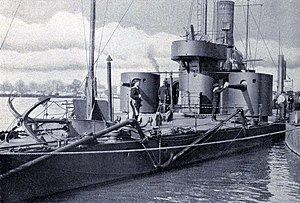 SMS Bodrog on the Danube river in 1914
| |
| History | |
|---|---|
| Name | Bodrog |
| Namesake | Bodrog River |
| In service | 2 August 1904 |
| Out of service | 1918 |
| Fate | Assigned to the Kingdom of Serbs, Croats and Slovenes (KSCS) |
| Name | Sava |
| Namesake | Sava River |
| Acquired | 15 April 1920 |
| Fate | Scuttled by the crew on 11/12 April 1941 |
| Name | Sava |
| Acquired | Raised and repaired |
| Fate | Scuttled by the crew 8/9 September 1944 |
| Name | Sava |
| Acquired | Raised and repaired |
| Reinstated | 1952 |
| Fate | Transferred to state-run company |
| Notes | Naval service ended in 1962 |
| Name | Sava |
| Acquired | By the Serbian Ministry of Defence and Military Museum in 2015 |
| Fate | Restored |
| Status |
|
| General characteristics | |
| Class and type | Temes-class river monitor |
| Displacement | 440 tonnes (430 long tons) |
| Length | 57.7 m (189 ft 4 in) |
| Beam | 9.5 m (31 ft 2 in) |
| Draught | 1.2 m (3 ft 11 in) |
| Installed power |
|
| Propulsion | 2 triple-expansion steam engines |
| Speed | 13 knots (24 km/h; 15 mph) |
| Complement | 77–79 officers and enlisted |
| Armament |
|
| Armour |
|
The Yugoslav monitor Sava is a Temes-class river monitor that was built for the Austro-Hungarian Navy as SMS Bodrog. She fired the first shots of World War I just after 01:00 on 29 July 1914, when she and two other monitors shelled Serbian defences near Belgrade. She was part of the Danube Flotilla, and fought the Serbian and Romanian armies from Belgrade to the mouth of the Danube. In the closing stages of the war, she was the last monitor to withdraw towards Budapest, but was captured by the Serbs when she grounded on a sandbank downstream from Belgrade. After the war, she was transferred to the newly created Kingdom of Serbs, Croats and Slovenes (later Yugoslavia), and renamed Sava. She remained in service throughout the interwar period, although budget restrictions meant she was not always in full commission.
During the German-led Axis invasion of Yugoslavia in April 1941, Sava served with the 1st Monitor Division. Along with her fellow monitor Vardar, she laid mines in the Danube near the Romanian border during the first few days of the invasion. The two monitors fought off several attacks by the Luftwaffe, but were forced to withdraw to Belgrade. Due to high river levels and low bridges, navigation was difficult, and Sava was scuttled on 11 April. Some of her crew tried to escape cross-country towards the southern Adriatic coast, but all were captured prior to the Yugoslav surrender. The vessel was later raised by the navy of the Axis puppet state known as the Independent State of Croatia and continued to serve as Sava until the night of 8 September 1944 when she was again scuttled.
Following World War II, Sava was raised once again, and was refurbished to serve in the Yugoslav Navy from 1952 to 1962. She was then transferred to a state-owned company that was eventually privatised. In 2005, the government of Serbia granted her limited heritage protection after citizens demanded that she be preserved as a floating museum, but little else was done to restore her at the time. In 2015, the Serbian Ministry of Defence and Belgrade's Military Museum acquired the ship. She was restored by early 2019 and opened as a floating museum in November 2021.